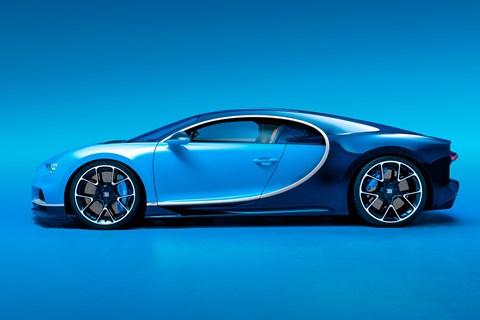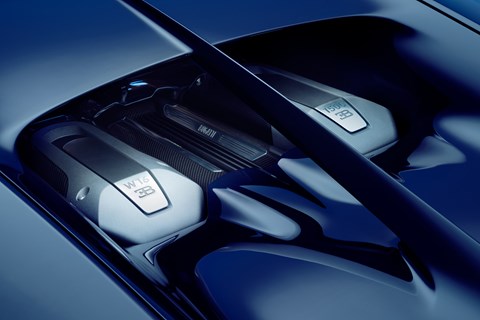► New Bugatti Chiron unveiled at 2016 Geneva show
► World’s most powerful production car with 1480bhp
► 500 cars to be built, yours for €2.4m (before options)
Consider the supercar goalposts moved. This is the new Bugatti Chiron, the world’s fastest, most powerful production car yet.
The successor to the Veyron, unveiled today prior to the Geneva motor show, costs more than 2.4m Euros, packs a 1480bhp punch and has a top speed limited to 261mph.
New Bugatti Chiron: the numbers
They’re big. The Chiron is shaping up to be the most unbeatable Top Trumps card ever.
It’s powered by an extensively redeveloped version of the Veyron’s 8.0-litre quad-turbo W16, which produces what is claimed to be the highest figure yet extracted from a production car: 1500 metric horsepower (or 1480bhp). Maximum torque is an equally enormous 1180lb ft, spread between 2000 and 6000rpm.
Top speed is electronically limited for road use(!), to 420km/h (261mph). The limiter’s there primarily for reasons of tyre durability. That actually makes it a touch slower than the Veyron Super Sport’s record V-max of 267mph, but the maths say the Chiron could top 285-287mph or so with the limiter removed. Bugatti isn’t quoting an official unrestricted top speed for the time being.
Nor is there an official 0-62mph just yet, but Bugatti reckons it’ll be ‘less than’ 2.5 seconds.
From the CAR+ archive: 61 hours with a Bugatti Veyron – Georg Kacher spends three days with a Veyron in an epic 2006 feature

How much does the Bugatti Chiron cost?
Another big number: the basic price is €2.4 million.
Bugatti says production will be limited to 500 cars (although there’s surely a little wriggle room on that figure for the odd special edition) and claims to already have advance orders for a third of the production run. No doubt there might be a few more signatures in the order book following the Geneva show.
Don’t be surprised to see an even faster variant along the same lines as the Veyron Super Sport arrive later in the Chiron’s life cycle, although plans for a higher-performance version are yet to be confirmed by Bugatti.
Read CAR’s original scoop dossier on the new Bugatti Chiron

Bugatti Chiron: design
That striking bodywork is said to be partly inspired by elements of the Bugatti Type 57SC Atlantic, in particular the C-shaped curve that loops from the A-pillar all the way around the rear haunches and back through the front wheel arch – and the central fin from stem to stern, which is intended to be a more subtle version of the prominent similar central seam on the Atlantic.
The Chiron’s been designed with a two-tone colour scheme in mind like the Veyron, but single-colour options will also be available.
Despite its greater top speed, the Chiron is higher and wider than the Veyron and there’s more headroom and footwell space inside as a result.
The interior’s as opulent as you’d expect, with each Chiron’s cockpit tailor-made to its customer’s tastes. Here’s the official line: ‘If customers have special wishes concerning colours or materials, which is rather the rule than the exception at Bugatti, the designers and engineers will do everything in their power to take these into consideration.’
Digital displays sit inside the air-con dials, à la the Audi TT only rather more sophisticated – it’s possible to swap the climate readouts for driving data, so you or your passenger have a second visual on fluid temperatures, pressures, speed, power, fuel, gear selection and more.
Who was Louis Chiron, and why is Bugatti’s new hypercar named after him?

What sort of car does my 2.4 million Euros buy me, then? Talk me through the technical details…
Structure
A brand new carbon monocoque chassis, with LMP1 Le Mans prototype levels of rigidity (50,000Nm per degree – quite a lot, in other words).
The outer bodywork’s entirely composed of carbonfibre, beneath six layers of painstakingly applied clear coat.
Unlike the Veyron, you can now fit an air travel cabin baggage-sized 44-litre suitcase in the boot, thanks to the front radiator being canted back to create more space.
Engine
The Veyron’s 8.0-litre W16 returns, but not as we know it. It’s undergone some serious development to generate 25% more power than before – no mean feat.
Its pistons, con-rods and crank are all new, as is the titanium exhaust system. Much of the power gains come from the redesigned two-stage turbo system, employing four separate turbochargers that are 30% bigger than those of the Veyron Super Sport. The Chiron gets off the line with two turbos in action, with the other two chiming in above 3800rpm, creating the most linear power curve possible. Working out how to deliver 1480bhp in a controlled, manageable way can’t be easy.
Stronger components for higher output generally mean more weight, so lightweight materials are used where possible in the Chiron. The intake tube and timing chain housing are made from carbonfibre, for example, and the new crankshaft is lighter than the Veyron’s.
Some of the numbers associated with the Veyron’s powerplant are startling; the charge air cooling system swallows 60,000 litres of air per minute and in the same amount of time the coolant pump needs to circulate 800 litres of water through the engine.
As with the Veyron, the W16 is hooked up to a seven-speed dual-clutch gearbox and permanent four-wheel drive.
Suspension, brakes, tyres
The Chiron is fitted with a new ‘Adaptive Chassis’ suspension system with five driving programmes: Lift (to conquer speed bumps, or load onto a trailer), Auto (the default mode, which alters the ride height on the fly), Autobahn (for high-speed stability), Handling (max agility, best use on track) and Top Speed (activated by a second, separate ignition key to raise the limiter from 380kph to 420kph – a ritual carried over from the Veyron).
Redesigned suspension helps the tyres, specially developed by Michelin, to benefit from significantly larger contact patches than those of the Veyron. The boots measure 285/30 R20 at the front, 355/25 R21 at the rear.
The carbon-ceramic brake discs, made from carbon silicon carbide, have grown in size and are gripped by calipers with eight titanium pistons at the front, and six at the rear.
Aerodynamics
Active aero plays a big part in the Chiron’s performance. A hydraulic flap at the front axle helps lower drag and improve brake cooling, while the adaptive suspension (see the section above) allows the ground clearance to alter at speed and alters downforce levels as a result.
The rear spoiler automatically transitions between four positions: completely retracted, slightly extended (the position it adopts for Top Speed mode), completely extended (for Handling and Autobahn modes), and tilted fully forwards to act as an air brake under heavy deceleration.
Cooling
One of the biggest challenges of engineering a car built for such extreme speeds. There are two cooling water loops (high temp for engine and low temp for charge air cooling) and no less than 10 radiators in total, including one each for engine oil, transmission oil, and rear differential oil. Bugatti describes the Chiron’s cooling system as ‘the most sophisticated and highest performance ever installed on a sports car.’
Oh, and it’s got wi-fi on board too.

Statistics
Engine: 7993cc W16 quad-turbo, 1480bhp @ 6700rpm, 1180lb ft @ 2000-6000rpm
Transmission: Seven-speed dual-clutch gearbox, permanent four-wheel drive with Haldex coupling at front differential, electronically controlled locking rear differential
Suspension: Double-wishbone front and rear, electronically controlled adaptive dampers
Brakes: 420mm discs, eight-piston calipers (front), 400mm discs, six-piston calipers (rear)
Performance: Top speed 261mph (limited for ‘road use’) in Top Speed mode, 236mph in Handling mode, 0-62mph under 2.5sec
Weight: 1995kg dry
Read more of CAR’s 2016 Geneva motor show coverage here
Click here for CAR’s A-Z guide to the 2016 Geneva motor show